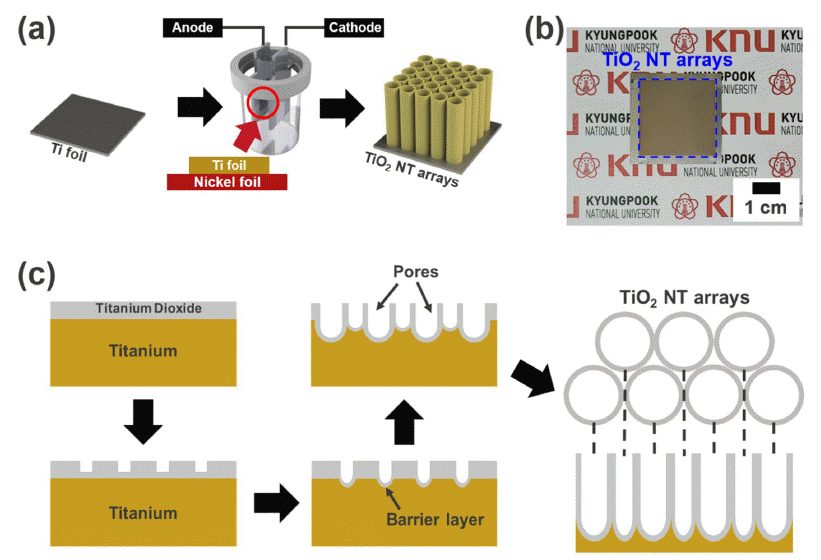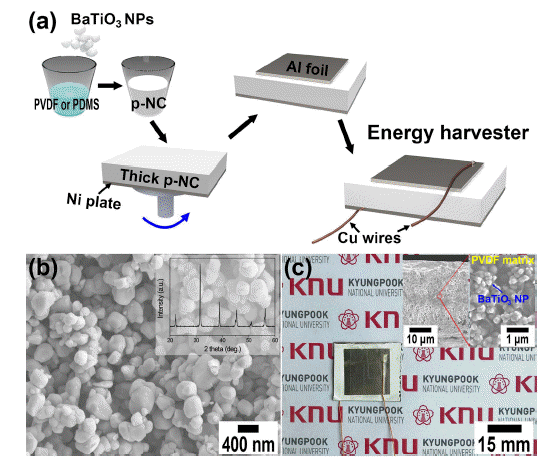Search
- Page Path
- HOME > Search
- [Korean]
- Effect of Hydrothermal Reaction Conditions on Piezoelectric Output Performance of One Dimensional BaTiO3 Nanotube Arrays
- Jae Hoon Lee, Dong Yeol Hyeon, Dong Hun Heo, Kwi-Il Park
- J Korean Powder Metall Inst. 2021;28(2):127-133. Published online April 1, 2021
- DOI: https://doi.org/10.4150/KPMI.2021.28.2.127

- 635 View
- 5 Download
- 2 Citations
-
 Abstract
Abstract
 PDF
PDF One-dimensional (1D) piezoelectric nanostructures are attractive candidates for energy generation because of their excellent piezoelectric properties attributed to their high aspect ratios and large surface areas. Vertically grown BaTiO3 nanotube (NT) arrays on conducting substrates are intensively studied because they can be easily synthesized with excellent uniformity and anisotropic orientation. In this study, we demonstrate the synthesis of 1D BaTiO3 NT arrays on a conductive Ti substrate by electrochemical anodization and sequential hydrothermal reactions. Subsequently, we explore the effect of hydrothermal reaction conditions on the piezoelectric energy conversion efficiency of the BaTiO3 NT arrays. Vertically aligned TiO2 NT arrays, which act as the initial template, are converted into BaTiO3 NT arrays using hydrothermal reaction with various concentrations of the Ba source and reaction times. To validate the electrical output performance of the BaTiO3 NT arrays, we measure the electricity generated from each NT array packaged with a conductive metal foil and epoxy under mechanical pushings. The generated output voltage signals from the BaTiO3 NT arrays increase with increasing concentration of the Ba source and reaction time. These results provide a new strategy for fabricating advanced 1D piezoelectric nanostructures by demonstrating the correlation between hydrothermal reaction conditions and piezoelectric output performance.
-
Citations
Citations to this article as recorded by- Optimized Process and Mechanical and Electrical Analysis of Polyimide/Pb(Zr,Ti)O3-Based Flexible Piezoelectric Composites
Junki Lee, Sang-il Yoon, Hyunseung Kim, Chang Kyu Jeong
Journal of Powder Materials.2025; 32(1): 16. CrossRef - Fabrication of Flexible Energy Harvester Based on BaTiO3 Piezoelectric Nanotube Arrays
Seo Young Yoon, Cheol Min Kim, Bitna Bae, Yujin Na, Haksu Jang, Kwi-Il Park
journal of Korean Powder Metallurgy Institute.2023; 30(6): 521. CrossRef
- Optimized Process and Mechanical and Electrical Analysis of Polyimide/Pb(Zr,Ti)O3-Based Flexible Piezoelectric Composites
- [Korean]
- A Comparison Study of Output Performance of Organic-Inorganic Piezoelectric Nanocomposite Made of Piezoelectric/Non-piezoelectric Polymers and BaTiO3 Nanoparticles
- Dong Yeol Hyeon, Kwi-Il Park
- J Korean Powder Metall Inst. 2019;26(2):119-125. Published online April 1, 2019
- DOI: https://doi.org/10.4150/KPMI.2019.26.2.119

- 553 View
- 3 Download
- 5 Citations
-
 Abstract
Abstract
 PDF
PDF Piezoelectric energy harvesting technology is attracting attention, as it can be used to convert more accessible mechanical energy resources to periodic electricity. Recent developments in the field of piezoelectric energy harvesters (PEHs) are associated with nanocomposites made from inorganic piezoelectric nanomaterials and organic elastomers. Here, we used the BaTiO3 nanoparticles and piezoelectric poly(vinylidene fluoride) (PVDF) polymeric matrix to fabricate the nanocomposites-based PEH to improve the output performance of PEHs. The piezoelectric nanocomposite is produced by dispersing the inorganic piezo-ceramic nanoparticles inside an organic piezo-polymer and subsequently spin-coat it onto a metal plate. The fabricated organic-inorganic piezoelectric nanocomposite-based PEH harvested the output voltage of ~1.5 V and current signals of ~90 nA under repeated mechanical pushings: these values are compared to those of energy devices made from non-piezoelectric polydimethylsiloxane (PDMS) elastomers and supported by a multiphysics simulation software.
-
Citations
Citations to this article as recorded by- Development and Characterization of Hafnium-Doped BaTiO3 Nanoparticle-Based Flexible Piezoelectric Devices
HakSu Jang, Hyeon Jun Park, Gwang Hyeon Kim, Gyoung-Ja Lee, Jae-Hoon Ji, Donghun Lee, Young Hwa Jung, Min-Ku Lee, Changyeon Baek, Kwi-Il Park
JOURNAL OF SENSOR SCIENCE AND TECHNOLOGY.2024; 33(1): 34. CrossRef - Enhanced energy harvesting of fibrous composite membranes via plasma-piezopolymer interaction
Hyeon Jun Park, Bitna Bae, HakSu Jang, Dong Yeol Hyeon, Dong Hun Lee, Gwang Hyun Kim, Cheol Min Kim, Nagamalleswara Rao Alluri, Changyeon Baek, Min-Ku Lee, Gyoung-Ja Lee, Kwi-Il Park
Nano Energy.2024; 131: 110299. CrossRef - Effects of Mixing Ratio and Poling on Output Characteristics of BaTiO3-Poly Vinylidene Fluoride Composite Piezoelectric Generators
Hee-Tae Kim, Sang-Shik Park
Korean Journal of Materials Research.2023; 33(12): 517. CrossRef - Stretchable Sensor Array Based on Lead-Free Piezoelectric Composites Made of BaTiO3 Nanoparticles and Polymeric Matrix
Jun Ho Bae, Seong Su Ham, Sung Cheol Park, Kwi-Il Park
JOURNAL OF SENSOR SCIENCE AND TECHNOLOGY.2022; 31(5): 312. CrossRef - Flexible Energy Harvester Made of Organic-Inorganic Hybrid Piezoelectric Nanocomposite
Yu Jeong Kwon, Dong Yeol Hyeon, Kwi-Il Park
Korean Journal of Materials Research.2019; 29(6): 371. CrossRef
- Development and Characterization of Hafnium-Doped BaTiO3 Nanoparticle-Based Flexible Piezoelectric Devices
TOP
 kpmi
kpmi


 First
First Prev
Prev


